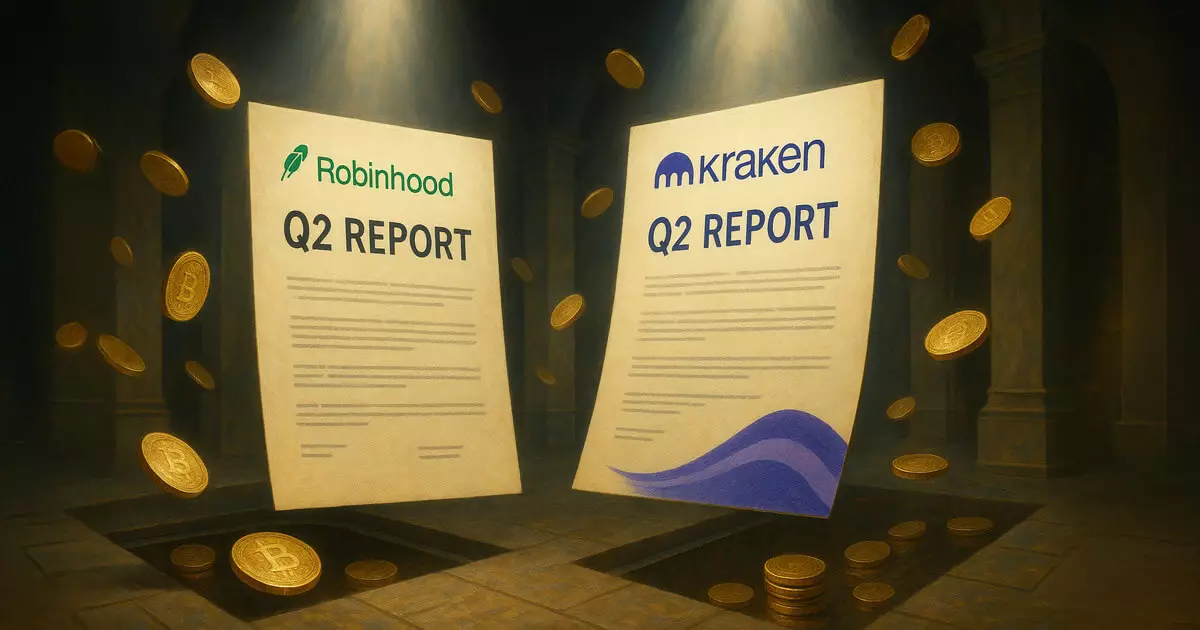In the midst of mounting global economic uncertainty, the recent quarterly reports from Robinhood and Kraken seem to paint a picture of resilience and innovation within the crypto landscape. Yet, a deeper analysis reveals that these apparent triumphs might be more superficial than they seem. While both platforms boast impressive year-over-year growth figures, their quarter-over-quarter (QoQ) declines suggest underlying vulnerabilities. This contradictory narrative raises the question: Are these companies truly solidifying their hold on the market, or are they merely riding the waves of transient hype and short-term opportunism?
Robinhood’s latest earnings highlight a market heavily driven by crypto activity. A 98% YoY increase in crypto revenues is undoubtedly remarkable, but a closer inspection shows that this surge is increasingly reliant on volatile transactional spikes rather than sustainable growth. The company’s push into tokenized equities and the deployment of Layer 2 solutions on Ethereum indicate a desperation to stay ahead of competitors and capture fleeting market share. These initiatives might seem innovative, yet they also signify a shift towards highly speculative assets, which are inherently risky for retail investors and could lead to a future crisis if markets turn sour.
Conversely, Kraken’s figures suggest a story of cautious resilience. While total revenue experienced a marginal QoQ decline of 13%, the platform’s user base continues to flourish, with funded accounts increasing by over a third compared to last year. Kraken’s emphasis on proof-of-reserve audits and regulatory compliance further underscores a strategic effort to build trust amid regulatory crackdowns worldwide. Nevertheless, the decline in trading volume and revenue hints at a broader industry slowdown. The apparent growth in assets under management could be masking concerns about the sustainability of higher asset values in a volatile market environment. As Kraken consolidates its position through regulatory approval and market share gains, it remains vulnerable to external shocks—a reality that the optimistic narratives often overlook.
Market Volatility: The Silent Enemy
Both Robinhood and Kraken operate within a tumultuous macroeconomic context characterized by inflationary pressures, geopolitical tensions, and regulatory uncertainties. These factors inevitably trickle down to the crypto sector, which, despite its promise of decentralization and innovation, remains highly sensitive to external shocks. The impressive YoY metrics may reflect a temporary rebound or a speculative bubble rather than genuine, long-term growth. A consistent quarter-over-quarter decline indicates that investor enthusiasm might be waning, and the market is yet to stabilize at a sustainable level.
The strategic moves of these platforms—such as Robinhood’s expansion into tokenized assets and Ethereum-based protocols—are more reflective of a desperate attempt to capture user interest before the next downturn. Such innovations, while exciting on the surface, also impose new risks and complexities. Tokenized equities and Layer 2 solutions are still nascent, untested in many ways, and could become liabilities if market sentiment turns negative or regulatory scrutiny intensifies. Kraken’s focus on compliance and reserve transparency lends a more reassuring outlook; yet, it cannot entirely shield itself from systemic risks.
The Future: Thriving or Just Surviving?
The indicators from Robinhood and Kraken suggest a market caught between reckless exuberance and cautious recalibration. Their growing user bases and asset holdings are positive signs, but these figures may mislead investors into complacency. Underneath the surface lies a fragile ecosystem vulnerable to external shocks, regulatory clampdowns, and internal miscalculations. The question remains whether these platforms are genuinely shaping the future of finance or merely capitalizing on a temporary phase of enthusiasm before reality reasserts itself.
From a center-right perspective emphasizing prudent regulation, balanced innovation, and sustainable economic growth, it’s clear that riding the wave of short-term gains without addressing inherent risks is a gamble with potentially disastrous consequences. As these giants continue their expansion, both the industry and its participants must exercise disciplined skepticism, recognizing that not every upward tick signifies lasting progress. The real challenge—and opportunity—lies in fostering an environment that rewards resilience over hype, innovation over speculation, and integrity over short-circuiting regulation. Only then can the crypto space hope to evolve into a mature, responsible pillar of the financial system, rather than a fleeting spectacle of transient gains both promising and perilous.

